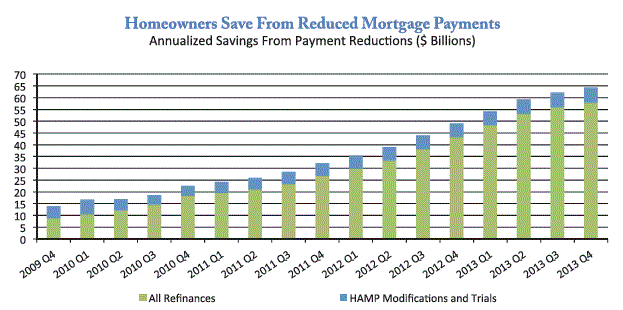Blog

Housing Scorecard Focuses on Principal Reduction Program
The February edition of the ObamarnAdministrations Housing Scorecard was released late Friday by the Departmentsrnof Treasury and Housing and Urban Development along with the monthly report,rnfor January, of the Making Home Affordable (MHA) program. Thernscorecard notes that purchases of new homes rose, foreclosure completionsrncontinued their downward trend, and house prices were stable.</p
While much of the data summarized inrnthe Scorecard has previously been reported by MND there were a few bits ofrnnews. First, the Federal Reserve reportsrnthat homeowners’ equity was up nearly $412 billion, or 4.3 percent, in thernfourth quarter of 2013, reaching $10.026 trillion-the highest level since thernfourth quarter of 2007. Homeowners’ equity has risen sharply since thernbeginning of 2012, with equity up 60 percent, or more than $3.7 trillion,rnduring this period. In last week’s negative equity report CoreLogic hadrnput the fourth quarter increase in equity at slightly under $3 billion andrncalled the number of home affected virtually unchanged from the third quarter. </p
The Neighborhood Stabilization Program (NSP)rncontinues to help communities across all 50 states address foreclosed andrnabandoned homes. During the fourth quarter of 2013,rngrantees report cumulative completions of newly constructed or rehabilitatedrnhousing units under NSP topping 32,000 units, while direct assistance tornhomeowners reached the 10,800 mark, signaling strong progress toward achievingrnprojected activity under the NSP1, NSP2, and NSP3 programs.</p
The MHA report includesrninformation on the handful of initiatives that operate under that umbrella includingrnthe Home Affordable Modification Program (HAMP), Home Affordable ForeclosurernAlternatives (HAFA), the second lien modification program (2MP) and thernUnemployment program (UP). The reportrnthis month focused on the HAMP Principal Reduction Alternative (PRA).</p
HAMP initiated 12,025 new loanrnmodification trials in January, bringing the total since the program began to 2.16rnmillion. There were 15,729 trialrnmodifications converted to permanent modification status since the previous MHArnreport for December. Of the 1.33 millionrnpermanent modifications put in place since the program began in April 2009,rn933,900 remained active at the end of January. rn</p
Acting Assistant Treasury SecretaryrnTim Bowler said of HAMP, “January’s MHA report shows that homeowners currentlyrnin the Home Affordable Mortgage Program (HAMP) have saved a total estimatedrn$25.5 billion to date in monthly mortgage payments.”</p
Homeowners currently in HAMPrnpermanent modifications with some form of principal reduction have been grantedrnan estimated $13.3 billion in reductions. rnLoans owned or guaranteed by Fannie Mae or Freddie Mac (the GSEs) arernnot eligible for a HAMP PRA due to a ruling from the Federal Housing FinancernAgency (FHFA) which acts as their conservator. rnHowever, of eligible non-GSE loan that entered HAMP in January, 64rnpercent received a principal reduction. Fifty-sixrnpercent of loans received a PRA reduction where the servicer received incentivernpayments from Treasury for providing the reduction. The other 4 percent were done outside of HAMPrnrequirements and without servicer incentives. rnIn December 56 percent of loans received a principal reduction with 47rnpercent meeting HAMP requirements.</p
 </p
</p
MHA said while the population ofrnloan modifications that include principal reductions is still relatively small,rnprogram data indicates that modifications with principal reduction include morernhomeowners seriously delinquent at the time the trial period begins, 84 percentrnare over 60 days in arrears, compared to 80 percent in the overall HAMPrnpopulation. Homeowners receivingrnprincipal reduction also have higher before-modification loan-to-value ratiosrnthan those without it, a median of 148 percent compared to 119 percent.</p
MHA’s monthly report also includesrndata on its Quarterly Servicer Assessment. rnIn the fourth quarter only one servicer, JP Morgan Chase, was found tornneed minor improvement. Wells FargornBank, N.A was found to need moderaternimprovement, however, their compliance results approached the levelrnrequired for a determination of minor improvement. The remainder, Bank of America, N.A, CitiMortgage,rnInc., Nationstar Mortgage LLC, Ocwen Loan Servicing, LLC and Select PortfoliornServicing, Inc. were found to need moderaternimprovement.</p
“The standards set by the Making HomernAffordable (MHA) program and our quarterly servicer assessments have positivelyrnimpacted the mortgage servicing industry,” Bowler said. “While the housingrnmarket as a whole has made significant progress, servicers still have room forrnimprovement and Treasury will continue to press the industry to improvernservicer performance.
All Content Copyright © 2003 – 2009 Brown House Media, Inc. All Rights Reserved.nReproduction in any form without permission of MortgageNewsDaily.com is prohibited.
Latest Articles
By John Gittelsohn August 24, 2020, 4:00 AM PDT Some of the largest real estate investors are walking away from Read More...
Late-Stage Delinquencies are SurgingAug 21 2020, 11:59AM Like the report from Black Knight earlier today, the second quarter National Delinquency Survey from the Read More...
Published by the Federal Reserve Bank of San FranciscoIt was recently published by the Federal Reserve Bank of San Francisco, which is about as official as you can Read More...

Comments
Leave a Comment